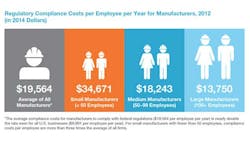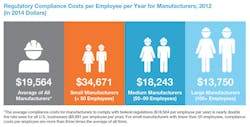Regulations: Why Small Manufacturers Face a 'Double Whammy'
Small businesses and manufacturers carry a disproportionate share of the $2.023 trillion burden that federal regulations impose on the economy annually, according to a new study from the National Association of Manufacturers.
The study, conducted by economists Nicole V. and W. Mark Crain of Lafayette College, found that the average U.S. company pays $9,991 per employee per year to comply with federal regulations. However, the average manufacturer pays nearly double that amount – $19,564 per employee annually. And for small manufacturers with less than 50 employees, the cost of regulations is an estimated $34,671 per employee.
The report states the reason for the cost disparity is due to economies of scale. “Some of the costs associated with regulatory compliance are fixed costs, so a firm with 20 employees incurs roughly the same expense as a firm with 500 employees. Large firms spread these fixed costs over larger revenues, or output, and larger employee base, resulting in lower costs per unit of output as the firm size increases,” the report explained.
“If you’re a small manufacturer, you’re getting a double whammy from the cost of regulation,” W. Mark Crain commented in a press conference.
Timmons said the Obama administration and past administrations have taken steps to reduce the regulatory burden but he said agencies have “inconsistently analyzed” the impacts of their regulations and how they affect businesses.
As an example, Timmons pointed to the EPA’s current review of the ozone standard regulated under the Clean Air Act. EPA is conducting a review required by law and a staff report has recommended that the agency consider reducing the standard from the current 75 parts per billion to as little as 60 ppb.
NAM has warned that such a level could reduce U.S. GDP by $270 billion, result in 2.9 million fewer jobs and increase natural gas and electricity costs.
“This move could usher in the most expensive regulation in our history and, frankly, could tank our economy,” Timmons said.
The NAM president said he hopes the study will be part of an ongoing dialog about regulations and their costs. “Quite frankly, if it is part of the discussion leading into the Congressional discussions this year and the president election in 2016, we are very pleased to have that be part of the dialog,” Timmons said, adding, “We support regulations to assure appropriate protections for workers and for the general public. But at the same time, at some juncture, you have to ask yourself, ‘How much is too much?’”
About the Author
Steve Minter
Steve Minter, Executive Editor
Focus: Leadership, Global Economy, Energy
Call: 216-931-9281
Follow on Twitter: @SgMinterIW
An award-winning editor, Executive Editor Steve Minter covers leadership, global economic and trade issues and energy, tackling subject matter ranging from CEO profiles and leadership theories to economic trends and energy policy. As well, he supervises content development for editorial products including the magazine, IndustryWeek.com, research and information products, and conferences.
Before joining the IW staff, Steve was publisher and editorial director of Penton Media’s EHS Today, where he was instrumental in the development of the Champions of Safety and America’s Safest Companies recognition programs.
Steve received his B.A. in English from Oberlin College. He is married and has two adult children.

